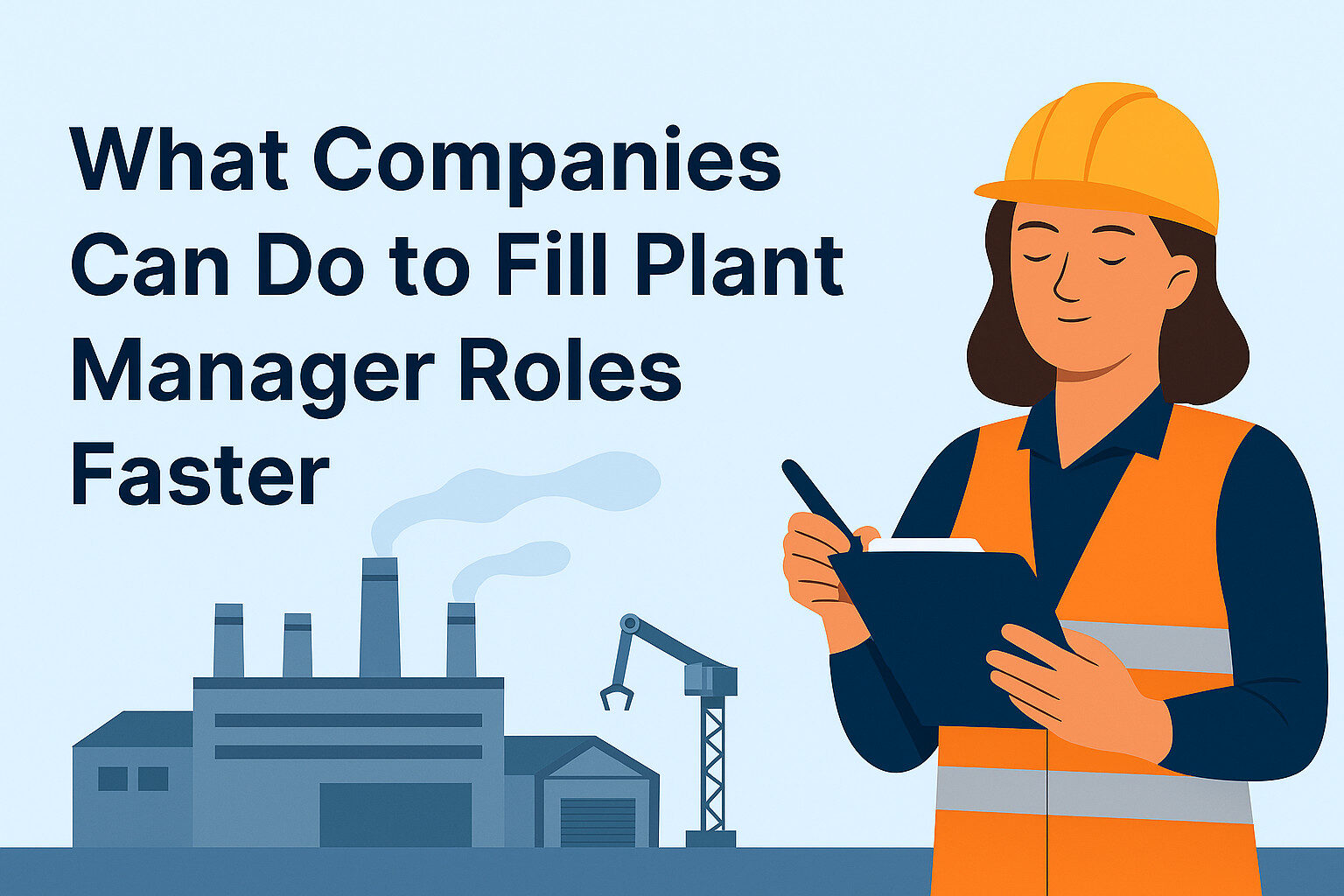Finding the right plant manager is one of the toughest challenges in industrial recruiting today. While the role is critical to operations, safety, quality, and profitability—companies across the U.S. are struggling to identify, attract, and retain the right candidates.
This isn’t just a hiring inconvenience. It’s a real business risk.
In this blog post, we’ll explore why plant manager roles are so difficult to fill, what the data tells us about the talent gap, and what you can do differently to build stronger pipelines and make better hires.
Why Plant Managers Matter More Than Ever

A plant manager is more than just a people leader—they’re the engine of a facility’s performance. They must balance:
- Production efficiency
- Cost control
- Safety protocols
- Workforce management
- Quality assurance
- Regulatory compliance
They report to the executive team while managing front-line supervisors, engineers, and technicians. In short: they turn strategy into execution.
And when that role is vacant—or filled poorly—it shows.
The Data Behind the Drought
According to recent labor statistics:
- The average tenure of a plant manager in the U.S. is just 3.2 years.
- Over 30% of open plant manager roles remain unfilled after 90 days.
- Baby boomer retirements are removing 6,000+ operations leaders from the workforce every month.
Top Industries Struggling to Hire:
- Food and beverage manufacturing
- Automotive parts and components
- Consumer packaged goods (CPG)
- Plastics and chemical processing
- Metal fabrication and industrial machinery
The 5 Main Reasons These Roles Are Hard to Fill

1. Experience Requirements Are Extremely High
Plant managers are often expected to have:
- 10–15 years of manufacturing experience
- At least 5 years in a leadership role
- Industry-specific knowledge (e.g., GMP, Lean, Six Sigma)
- ERP fluency, labor law familiarity, OSHA expertise
That’s a long list—and few candidates check every box.
2. The Job Demands Are Intense
Many plant managers are:
- On-call 24/7
- Managing union and non-union workers
- Expected to deliver cost savings and culture change
- Measured on safety, output, morale, and uptime
It’s a high-pressure, high-accountability role—not everyone wants the stress, especially post-pandemic.
3. Geographic Constraints
Most manufacturing facilities are not in major cities—they’re in suburbs, rural hubs, or industrial corridors.
That means:
- Fewer local candidates
- Relocation is often required
- Families may be hesitant to move to lesser-known areas
4. Poor Employer Branding
Too many companies don’t market the impact, purpose, or benefits of the role.
Instead of:
“Come lead 120 people and shape our operations”
they post:
“We need someone with 10+ years of experience to manage KPIs”
That won’t inspire modern leaders.
5. Broken Hiring Processes
Many companies:
- Post generic job ads
- Use outdated HR systems
- Don’t screen or interview effectively
- Wait too long to make decisions
Meanwhile, top candidates get picked up elsewhere—often by competitors with sharper recruitment strategies.
What Companies Can Do to Fill Plant Manager Roles Faster

1. Define What Success Actually Looks Like
Start with outcomes, not just responsibilities. A clear success profile includes:
- First 90-day KPIs
- People leadership expectations
- Process improvement goals
- Cultural alignment (especially post-acquisition or during change)
This helps you screen better—and helps candidates self-select.
2. Build a Specialized Talent Pipeline
Don’t rely on job boards. Instead:
- Use a specialist recruiter who understands your industry
- Tap into passive talent via headhunting and referrals
- Connect with alumni from top-tier manufacturers
- Build a “bench” of future leaders from your supervisor and lead tech pool
At Talent Traction, we maintain an active database of plant leaders in core U.S. manufacturing sectors.
3. Offer Relocation and Family Support
If you need someone to move, make it easier:
- Offer relocation stipends
- Help with housing or cost-of-living education
- Provide support for spouse employment or school connections
The easier the transition, the more likely a leader will say yes.
4. Sell the Role, Don’t Just Post It
Revamp your employer branding:
- Highlight team size, impact, and visibility to execs
- Include quotes from current ops leaders
- Share a “Day in the Life”
- Communicate benefits like autonomy, innovation, and advancement
5. Shorten the Decision Cycle
Speed matters.
Top plant manager candidates are often interviewing at 3–4 places. A delay of even 5 days can cost you your best candidate.
Use structured interview scorecards, consolidate interview panels, and give decision-makers clear hiring timelines.
Final Thoughts: Plant Manager Roles Require Precision
Hiring plant managers isn’t just about filling a role—it’s about securing leadership that will define your facility’s success for years to come.
If you’re:
- Losing candidates to competitors
- Seeing high turnover in operations
- Struggling to scale your pipeline
Then it’s time to move from reactive hiring to a strategic recruitment partnership.
Talent Traction can help.




